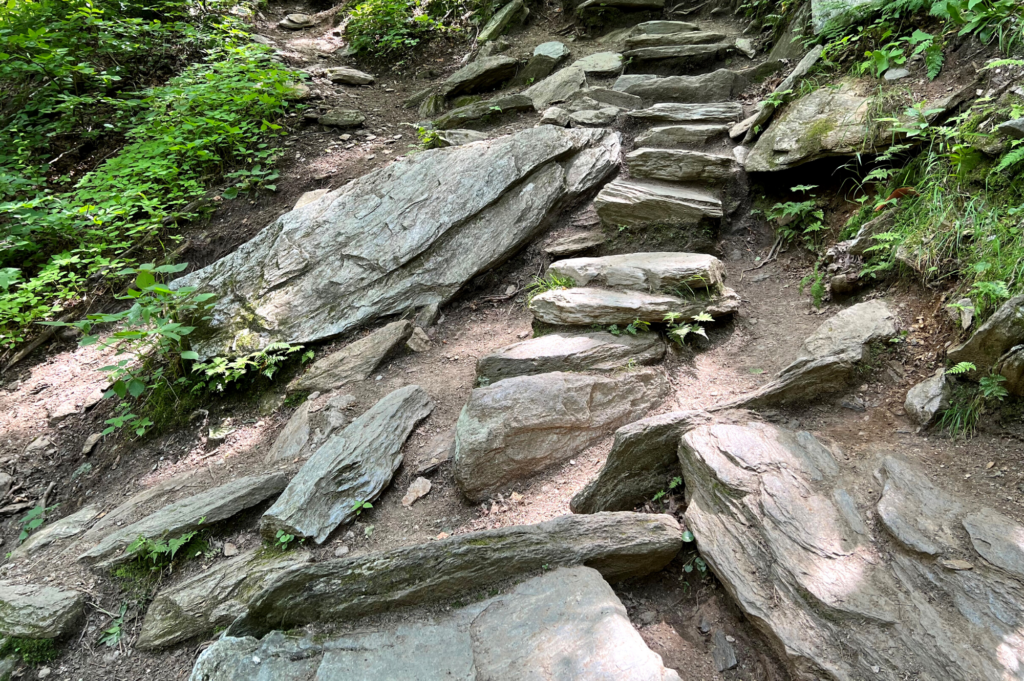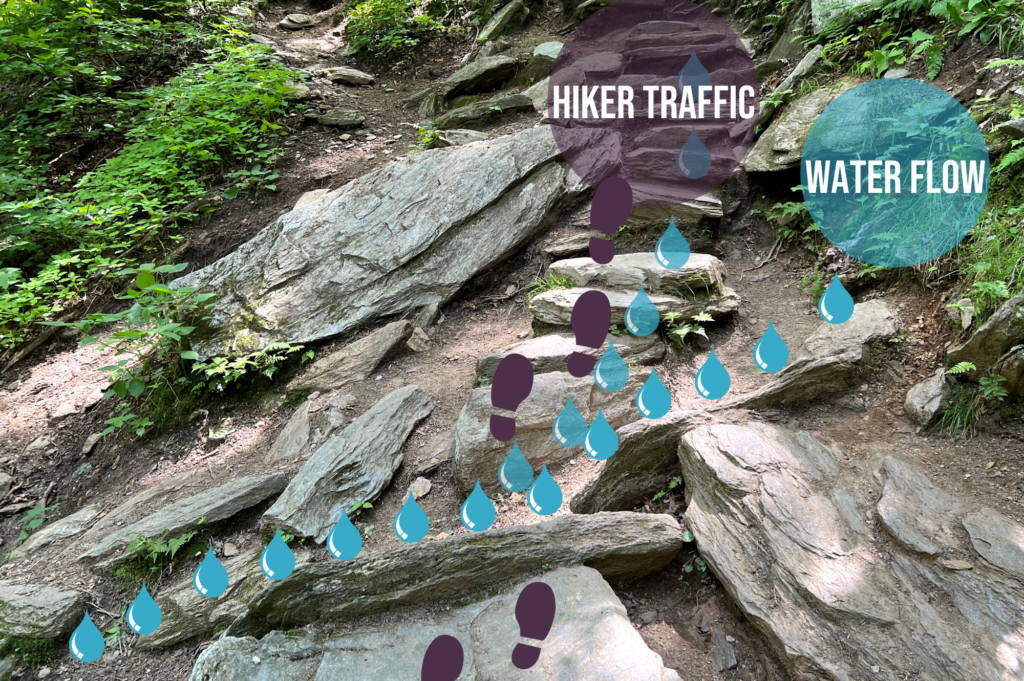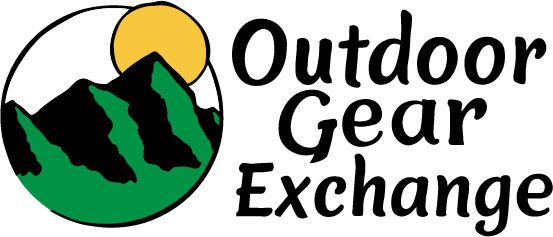
“Erosion is what causes all the problems on trail,” says Kevin Hart, GMC field supervisor of the Long Trail Patrol. “The main goal of trail crew is to stop erosion.”
Kevin’s not talking about bear encounters or overflowing privies or litter in firepits when he says “problems.” He’s talking about trail degradation. You know what that looks like: those deep gullies in the middle of the trail; widened, vegetation-less areas; and exposed roots and rocks.
So what is erosion and how does it cause trail degradation? Kevin explained to his trail crew before the hiking season began with a quick demo. Follow along, as Kevin does a second demonstration to explain why erosion is a problem, why it’ll never go away, and how trail crews like the Long Trail Patrol upkeep and create sustainable trails.
What is erosion?
Erosion is the process of earthen materials (like soil and rock) being worn down and transported by natural forces such as wind, flowing water, or glacial ice. National Geographic has a great explainer here.
“Erosion is always happening, but it’s happening so slowly that you can’t usually see it,” says Kevin.The exceptions are big storms and flash flooding, where a lot of water moves materials very quickly.
As climate change increases the frequency and intensity of rain events, these will further expedite trail erosion. Looking into the next decade, climate change related storms are one of GMC’s biggest challenges.
If erosion is normal, why is it a problem?
Erosion can be particularly problematic around Vermont’s trail system because the Long Trail was built over a hundred years ago, long before sustainability was a consideration, says Kevin. “So many of our trails follow what’s called the fall line.”
A fall line is the path that follows a mountain most directly downhill, he explains. And because it offers the least resistance, it’s also where water gathers. (Compare it to a switchback, or a trail that zigzags up the steep terrain instead of mimicking the slope.)
“As the water channels along the fall line, it picks up speed, has more power, and causes more erosion,” explains Kevin. This exacerbates the wear-and-tear along Vermont’s Long Trail.
Comparatively, when there is a switchback trail, the runoff water moves downhill in “sheets,” says Kevin. (Imagine flat and evenly dispersed.) Some of the water is absorbed into the relatively horizontal switchback trails, compared to funneling down the more vertical fall-line trails.
How do trail crews stop this?

“You can’t reverse erosion, but you can stop erosion on existing trails or build sustainable trails,” says Kevin. To stop water erosion, trail crews mainly use two methods: waterbars and stone stairs.
#1. The Waterbar
You’ve stepped over waterbars on trail: they’re the narrow drainage channels — usually fortified with rocks — that divert water off trail and into the forest. “[The water] ends up dispersing into the woods. It’s no longer stuck in a gullied path,” says Kevin.
Trail crews and volunteers regularly clear waterbars of leaves and other debris to keep them working efficiently. Waterbars prevent water from following the fall line and lead the runoff to be absorbed by surrounding vegetation.
#2. The Stone Stairs
Rock stairs, which take the form of checksteps and stone staircases, create a durable surface. “Stone stairs are more resistant to erosion than dirt,” explains Kevin. “Water flows over the rock and essentially protects the trail surface. It keeps the gully [that exists] from deepening.”
Stone steps have another benefit, says Kevin. Because they confine traffic to a durable surface, they prevent plants from getting trampled and encourage vegetation to return around the trail. Roots help anchor the soil in place, slowing erosion.
These types of structures exist all over the Long Trail System; spot them on Stratton Mountain, the Sunset Ridge Trail up Mansfield, and the Monroe Trail to Camel’s Hump, says Kevin.
Why can’t we reroute the trail to a more sustainable location?
“A reroute is ideal, but it’s not as practical as it could be,” says Kevin. Sometimes barriers, such as private land or a ledge, prevent crews from moving the trail, he explains. More commonly, there’s not enough resources to reroute a trail.
How can trail users help curb erosion?
The best thing you can do as a trail user is to stick to the trail. Hiking around steep staircases, tree roots, mud puddles, and other trail features widens the path and increases trail erosion. The problem with a widened trail is twofold:
- Hikers disturb and kill off vegetation. Plant roots help anchor the soil in place, and without them, the soil becomes loose and easily picked up by runoff.
- Increased foot traffic compacts the soil, removing air pockets that water would normally seep into. When the rain and snowmelt cannot seep into the ground, it continues along the surface, picking up sediments as it goes.
You’ll notice some of these issues on popular trails, like the Burrows Trail to the Camel’s Hump summit (which is currently getting a revamp). This steep, challenging trail tempts hikers to create their own routes; in doing so, trail users have widened the trail in areas. In doing so, water now has multiple paths to travel downhill, instead of the intended, durable path that trail crews designed.



















Install high-density polyethylene grids to promote ground stabilization and reduce erosion. BaseCore™ produces structural integrity that costs less time and money than geomembranes and concrete.